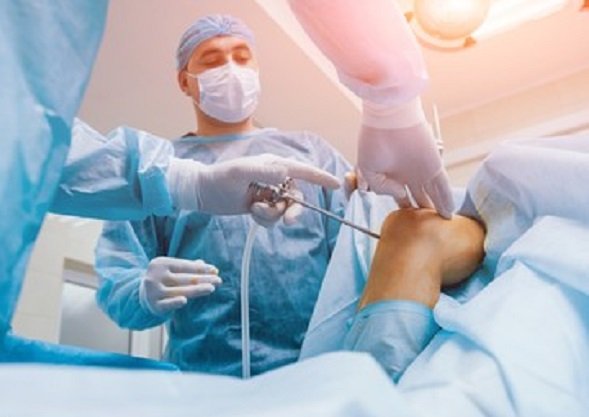Know more on arthroscopic surgeries for slip & fall injuries
December 24, 2021 | Friday | News | By Dr Ayyappan V Nair, Consultant - Shoulder Surgery, Sports Medicine and Arthroscopy, Manipal Hospital Jayanagar, Bengaluru
The male/female shoulder injury incidence ratio is 3:6 in the younger individuals, whereas the female/male incidence ratio is 2:1 in old age
Image credit: Shutterstock
Shoulder injuries are most common in overhead athletes as well as in normal group populations. Shoulder injuries are found in 30 per cent of the athletes during their athletic careers. Subacromial impingement syndrome and rotator cuff tendonitis are responsible for 27 per cent and 24 per cent of all shoulder injuries, respectively. Anterior shoulder instability affects about 1 per cent to 2 per cent of the general population and upto15 per cent of athletes participating in contact sports. The median age is 37 years, 51 years in women and 31 years in men. The overall incidence is more in males compared to females i.e., 60 per cent.
The male/female shoulder injury incidence ratio is 3:6 in the younger individuals, whereas the female/male incidence ratio is 2:1 in old age.
Almost half of the injuries are soft tissue injuries, 35 per cent are fractures and 17 per cent are dislocations. The incidence of fractures is more in children up to 10 years and in adults over 60 years. Soft tissue injuries are on the other hand more common in young and middle-aged people. The highest dislocation incidence rates are found in young males. Rotator cuff tears are diagnosed in 4 per cent of the injuries.
Similarly, knee injuries are also noticed in sportspersons and the general population. Women are at higher risk of ligament injury than men. Individuals of 15 to 24 years of age have the highest injury rate and children who are younger than 5 years have the lowest rate. Additionally, 42 per cent of individuals who are 65 years and older tend to have a higher proportion of injury due to stairs, ramps, landings, and floors.
Injuries to the knee account for 41 per cent of all sports injuries. Meniscal tears account for about 11 per cent of all knee injuries, while ligament injuries account for 40 per cent.
The anterior cruciate ligament is the most frequently injured of all knee ligaments (49 per cent). 33 per cent of ACL injured patients are symptomatic on day-to-day activities, 33 per cent are symptomatic only on sporting activities while the remaining 33 per cent are asymptomatic. Meniscus injuries accompany 60 per cent of ACL injuries, other ligament injuries seen in 20 per cent and osteochondral defects seen in 10-20 per cent of ACL injuries.
A degenerative meniscus injury is seen in old age and the risk of developing osteoarthritis of the knee by 65 years is 14 per cent in those who had a knee injury at a younger age as compared to a risk of 6 per cent in those who did not.
Similarly, active sports and domestic fall injuries are also seen in the ankle, hip, elbow and wrist joints.
ARTHROSCOPY
The history of Arthroscopy goes back to the 18th century but major advances took place in the 19th century and in 1918, Dr Kenji Takagi from Tokyo used a cystoscope to examine patient knees. Later a student of Takagi, Masaki Watanabe, published techniques and in 1958 he developed the first arthroscope. Dr Robert Jackson from Toronto went to Tokyo for training and published the first English literature in 1976 and also performed some of the first arthroscopic surgeries in North America. Now almost all procedures of joint injuries are carried out by Arthroscopic surgery like,
- Shoulder: Rotator cuff repair, management of SLAP tears, treatment of impingement, instability, biopsy, removal of loose bodies
- Knee: ACL or PCL tear debridement or reconstruction, meniscal repair or debridement, meniscal cyst excision, treatment of osteochondral lesions, synovial biopsy or synovectomy determination of the uncertain origin of instability or pain, debridement of degenerative joint disease
- Hip: synovial biopsy or synovectomy, loose-body removal, treatment of labral tears
- Ankle: Ligament repair or reconstruction, synovial biopsy or synovectomy, loose-body removal, bone-spur removal, treatment of osteochondral lesions
- Elbow: Radial head fracture fixation, ligament repair or reconstruction, synovial biopsy or synovectomy, loose-body removal, debridement of cartilage lesions and osteophytes
- Wrist: Fracture fixation of carpal bones, synovial biopsy or synovectomy, loose-body removal, diagnosis or debridement of TFCC injuries
NANOSCOPE - the next generation needle size arthroscopy system - the future of arthroscope
Nanoscope operative arthroscopy uses a single-use camera attached to the tip of an instrument which is 2 mm in diameter, inserted into the space in the joint through a needle-like cannula. Local anaesthesia is applied to allow for relatively quick, painless, and minimally invasive insertion. The entire procedure can be performed at OPD and while the patient is fully awake.
Advantages of Nanoscope Arthroscopy
- It is a reliable and accurate alternative to MRI diagnostics, no need to endure waiting times to access MRI machines.
- Nanoscope operative arthroscopy is minimally invasive and provides unrestricted access to joint spaces.
- During the procedure, the patient is awake and even watch the imaging screen as it is performed. The surgeon can then explain the visualisations to the patient in real time.
- Nanoscope Arthroscopy is quick and painless, resulting in a much faster recovery time.
- It is less expensive than an MRI and exposes patients to fewer risks.
Dr Ayyappan V Nair, Consultant - Shoulder Surgery, Sports Medicine and Arthroscopy, Manipal Hospital Jayanagar, Bengaluru










